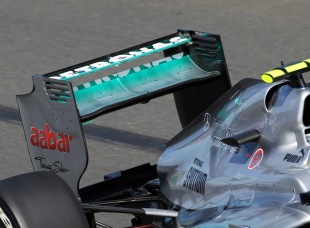- Mercedes news
Mercedes F-duct is nothing new - Lotus

- Drivers:
- Christian Horner
Lotus technical director James Allison believes Mercedes' DRS-activated F-duct is nothing new and has warned that it could spawn a new area of expensive development for the teams.
The Mercedes system works by exposing two inlets in the rear wing endplates when the DRS is activated that channel air towards the front of the car to stall the front wing and reduce drag. It appears to give the team a significant advantage in qualifying, when use of the DRS is unrestricted, but has less of an impact in the race, when DRS activation is limited to overtaking zones.
Lotus and Red Bull have questioned the device at both rounds so far and believe the system is operated by the driver and therefore illegal. At the end of the 2010 season the original F-duct, pioneered by McLaren, was banned with several teams - including Mercedes - concerned about the relevance of the system and escalating development costs. Allison believes the new Mercedes system, which has been declared legal by the FIA, is much the same.
"It's a secondary effect, but it's absolutely operated by the driver," he told Motor Sport. "Mercedes hasn't invented something; it was there, and other people were under the impression that it wasn't legal. If this is allowed you'll see everyone doing it, and it won't stop there, there are many, many other things that can happen."
Red Bull team principal Christian Horner revealed to Sky Sports on Friday that he is expecting the FIA to make a final decision on the system in China.
"Charlie Whiting, the [FIA] technical delegate, has been taking it all into consideration and there were several discussions with him over the [Malaysian GP] weekend. I think he wanted to have a think about it and of course we'll respect his position when he makes that clear to us in China. Then the teams are faced with alternatives. Either accept it and get on it and maybe look at your own solution if that fits your car. You've got the opportunity to protest if we were to feel, or any other team were to feel, that we didn't agree with Charlie's interpretation."
Horner said his team does not want to start working on it only to be told it is illegal at a later date.
"As with all devices like this it's how it interacts with the rest of the car," he added. "Of course I'm sure all the designers certainly at the front end of the grid have been looking at how the device works, how you would incorporate it into your own design. But before we pursue constructing parts and expense to it, for us it's quite important to know that, yes, it's going to be permissible for the rest of the year. And quite often we see technical clarifications come out that deem things to be not in compliance with the regulations."

